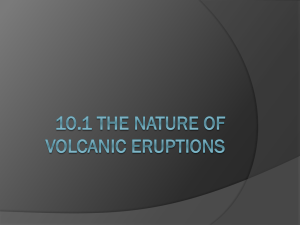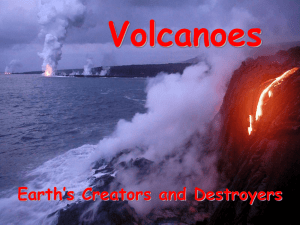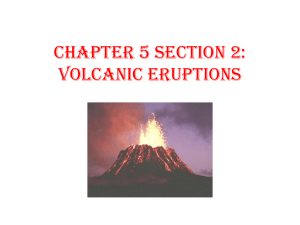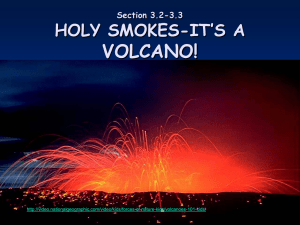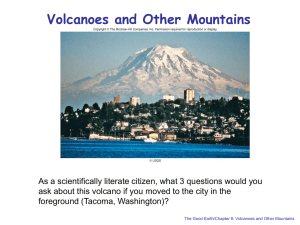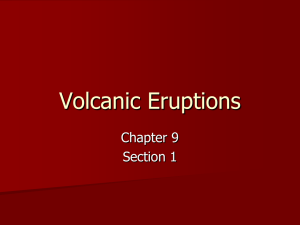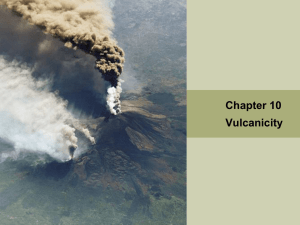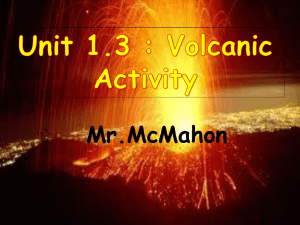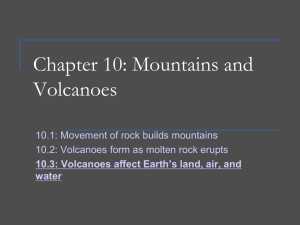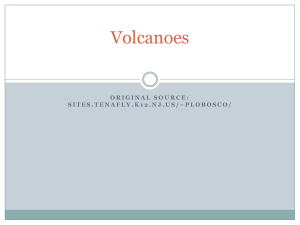CHAPTER 9 - Southern Local Schools
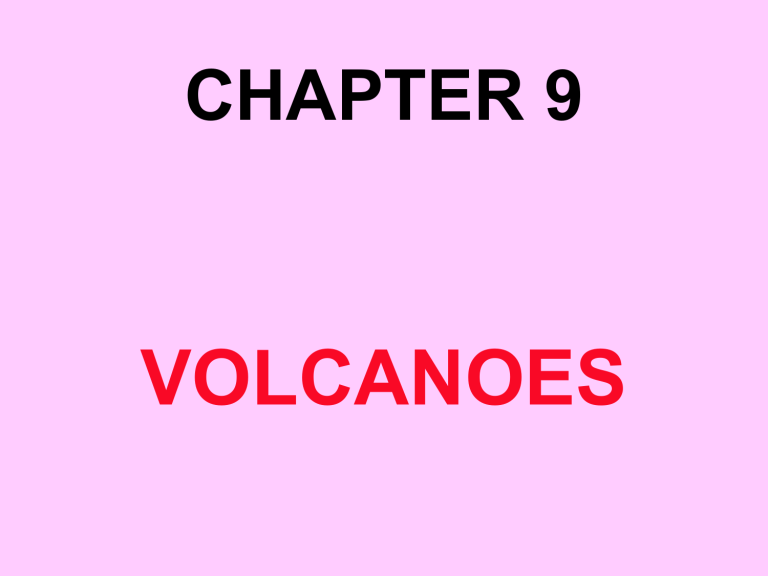
CHAPTER 9
VOLCANOES
VOLCANOES
Mt. Pinatubo
VOLCANOES
VOLCANOES
Most of the more than 600 active volcanoes that have been identified are located in the vicinity of convergent plates. Further, extensive volcanic activity occurs out of view along sea floor spreading centers of the oceanic ridge system.
The Origin of Volcanic Terms
Many terms for nonviolent eruptions are
Hawaiian. Drops of liquid lava that blow into fine spiky strands are called Pele’s hair, after the
Hawaiian goddess of fire. Limu o Pele, or
“Pele’s seaweed”, is the term for delicate, translucent sheets of spatter filled with tiny bubbles.
The term of violent eruptions, however, are generally not Hawaiian. Nuee ardente , French for “burning cloud”, is a hot mass of volcanic gases, ash and debris that is expelled explosively and then travels at hurricane speeds down a mountainside.
Pele’s Hair
IS IT A FACT!!!
The Tambora volcano eruption in Indonesia is the largest in the last 200 years. The volcano erupted on April 10 and 11, 1815. The eruption and the resulting tsunamis killed more than
10,000 people. Ash covered so much land that farmland was devastated; disease and famine killed 82,000 more.
During the Tambora eruption, so much ash was thrown into the atmosphere that weather patterns were affected worldwide.
Scholars believe the eruption cause the “Year Without a
Summer” in 1816, when snow fell in New
England in July.
Volcanoes Effects on Earth
The Krakatau Explosion
When the island of Krakatau, in Indonesia, exploded in 1883, it caused a shockwave that sped around the world seven times.
The volcano ejected about 18 km 3 of volcanic material into the air. One ash cloud reached 80 km high, and the explosion was heard on islands in the Indian Ocean nearly 4,600 km away. The ash clouds blocked out the sun and everything within 80km of the volcano was plunged into complete darkness for more than two days. The volcano collapsed and the island lost 21 km (2) of land. All that was left was a caldera lying as deep as 275 m beneath the ocean.
Krakatau contd.
In 1927, a cloud of sulfur and ash rose from the water above the volcano-
Krakatau’s magma chamber was not gone.
It was the beginning of Anak
Krakatau, or “Child of Krakatau”, which rose from the original volcano’s crater. By
1990, Anak Krakatau was 300 m high, and it continues to grow.
MISCONCEPTION ALERT
Although explosive volcanoes get the most attention, non-explosive extrusions play a much more significant role in shaping our world.
For instance, much of the ocean floor is covered by basaltic pillow lava, and non-explosive volcanoes formed many of the Pacific islands.
IS THAT A FACT!!!
The volcano Mauna Kea is the tallest mountain in the world. It rises 4 km above sea level, and its slopes descend 5 km below the ocean.
Hawaii’s mass depresses the ocean floor another 8 km. This makes the volcano 17 km tall, almost twice the height of Mount Everest!
Volcanic Eruptions
Think about the force of the explosion produced by the first atomic bomb used in
World War II. Now imagine an explosion
10,000 times stronger, and you get an idea of how powerful a volcanic eruption can be. As you may know, volcanic eruptions give rise to volcanoes.
A volcano is a mountain that forms when molten rock, called magma, is forced to the Earth’s surface.
Magma
Magma is molten or partially molten rock beneath the Earth's surface. When magma erupts onto the surface, it is called lava.
Magma typically consists of (1) a liquid portion (often referred to as the melt); (2) a solid portion made of minerals that crystallized directly from the melt; (3) solid rocks incorporated into the magma from along the conduit or reservoir, called xenoliths or inclusions; and (4) dissolved gases.
VOLCANOES
Fortunately, few volcanoes give rise to explosive eruptions like that of
Mount Pelee. Most eruptions are of a non-explosive variety.
You can compare these two types of eruptions by looking at the photographs on pages 222 and 223.
Non- explosive Eruptions
Lava flows from non-explosive eruptions.
Lava is magma that flows onto the Earth’s surface. Relatively calm outpourings of lava can release a huge amount of molten rock. Some of the largest mountains on Earth grew from repeated lava flows over hundreds of thousands of years.
Explosive Eruptions
In an explosive volcanic eruption, clouds of hot debris and gases shoot out from the volcano, often at supersonic speeds.
Instead of producing lava flows, molten rock is blown into millions of pieces that harden in the air.
The dust-sized particles can circle the globe for years in the upper atmosphere, while larger pieces of debris fall closer to the volcano.
In a matter of minutes, an explosive eruption can demolish rock formations that took thousands of years to accumulate. Thus, as shown a volcano may actually shrink in size rather than grow from repeated eruptions.
Cross Sections of a Volcano
Whether they produce explosive or nonexplosive eruptions, all volcanoes share the same basic features.
Deep underground, the driving force that creates volcanoes is hot liquid material known as magma. Magma rises through holes in the
Earth’s crust called vents.
Vents can channel magma all the way up to the
Earth’s surface during an eruption.
VENT
Located at the summit of many volcanoes is a steep-walled depression, crater, which is connected to a magma chamber via a pipe like conduit,
vent
.
VENT
Magma
By comparing the composition of magma from different types of eruptions, scientists have made an important discovery —the composition of the magma determines whether a volcanic eruption is non-explosive, explosive, or somewhere in between.
Water
A volcano is more likely to erupt explosively if its magma has a high water content.
The effect water has on magma is similar to the effect carbon dioxide gas has in a can of soda. When you shake the can up, the carbon dioxide that was dissolved in the soda is released, and because gasses need much more room than liquids, a great amount of pressure builds up.
When you open the can, soda comes shooting out.
The same phenomenon occurs with explosive volcanic eruptions.
Silica
Explosive eruptions are also caused by magma that contains a large percentage of silica (a basic building block of most minerals). Silica-rich magma has a thick, stiff consistency. It flows slowly and tends to harden in the volcano’s vent. This plugs the vent, resulting in a buildup of pressure as magma pushes up from below. If enough pressure builds up, an explosive eruption results.
What erupts from a Volcano?
Depending on how explosive a volcanic eruption is, magma erupts as either lava or pyroclastic material.
Pyroclastic material consists of the rock fragments created by explosive volcanic eruptions.
Non-explosive eruptions produce mostly lava.
Explosive eruptions produce mostly pyroclastic material.
Pyroclastic Flow
A pyroclastic flow is a ground-hugging avalanche of hot ash, pumice, rock fragments, and volcanic gas that rushes down the side of a volcano as fast as 100 km/hour or more. The temperature within a pyroclastic flow may be greater than 500 ° C, sufficient to burn and carbonize wood. Once deposited, the ash, pumice, and rock fragments may deform (flatten) and weld together because of the intense heat and the weight of the overlying material.
Pyroclastic Material
Pyroclastic Material is produced when magma explodes from a volcano and solidifies in the air. It comes in a variety of sizes, from boulders the sizes of houses to particles so small they can remain suspended in the atmosphere for years.
The photographs on page 226 show four major kinds of pyroclastic material: volcanic bombs, volcanic blocks, lapilli (luh
PILL ee), and volcanic ash.
Pyroclastic Material
Lava
Like magma, lava ranges in consistency from thick to thin. Block lava is so thick in consistency that it barely creeps along the ground.
Other types of lava, such as pahoehoe (pah HOY hoy), aa (AH ah), and pillow lava, are thinner in consistency and produce faster lava flows.
BLOCK LAVA
Block lava is cool, stiff lava that cannot travel far from the erupting vent. Block lava usually oozes from a volcano, forming jumbled heaps of sharp-edged chunks. A volcanic block is a solid rock fragment greater than 64 mm in diameter that was ejected from a volcano during an explosive eruption. Blocks commonly consist of solidified pieces of old lava flows that were part of a volcano's cone.
Block Lava
Pahoehoe
Pahoehoe lava flows slowly like wax dripping from a candle, forming a glassy surface with rounded wrinkles. Pahoehoe is a Hawaiian term for basaltic lava that has a smooth, hummocky, or ropy surface. A pahoehoe flow typically advances as a series of small lobes and toes that continually break out from a cooled crust.
The surface texture of pahoehoe flows varies widely, displaying all kinds of bizarre shapes often referred to as lava sculpture.
Pahoehoe
Aa
Aa is a Hawaiian word that refers to a type of lava that has a jagged surface. This slightly stiffer lava pours out quickly and forms a brittle crust. The crust is torn into jagged pieces as the molten lava underneath continues to move. A`a
(pronounced "ah-ah") is a Hawaiian term for lava flows that have a rough rubbly surface composed of broken lava blocks called clinkers.
Aa
Pillow lava
Pillow lava forms when lava erupts underwater.
As you can see here, it forms rounded lumps that are the size and shape of pillows. When basalts erupt underwater, they commonly form pillow lavas, which are mounds of elongate lava
"pillows" formed by repeated oozing and quenching of the hot basalt. First, a flexible glassy crust forms around the newly extruded lava, forming an expanded pillow. Next, pressure builds until the crust breaks and new basalt extrudes like toothpaste, forming another pillow.
This sequence continues until a thick sequence may be deposited. When geologists find pillow basalts in ancient rock sequences, they may conclude that the area was once under water.
Pillow lava
Bomb
Volcanic bombs are lava fragments that were ejected while viscous (partially molten) and smaller than 64 mm in diameter. Many acquire rounded aerodynamic shapes during their travel through the air. Volcanic bombs include breadcrust bombs, ribbon bombs, spindle bombs (with twisted ends), spheroidal bombs, and "cow-dung" bombs.
Bombs
Lava Tubes
Lava tubes are natural conduits through which lava travels beneath the surface of a lava flow.
Tubes form by the crusting over of lava channels and pahoehoe flows. A broad lava-flow field often consists of a main lava tube and a series of smaller tubes that supply lava to the front of one or more separate flows. When the supply of lava stops at the end of an eruption or lava is diverted elsewhere, lava in the tube system drains down slope and leaves partially empty conduits beneath the ground.
Lava Tubes
QUIZ
1) Describe the lava flow from a nonexplosive eruption.
2) Describe an explosive eruption.
3) Define blocky lava, pahoehoe lava and aa lava .
1) A calm stream that can flow for hundreds of kilometers
2) Ash, hot debris, gases and chunks of rock spew from a volcano
3) blocky lava: cool stiff lava that doesn’t travel very fast.
pahoehoe lava: flows quickly and forms a wrinkled surface, looks like coiled rope.
aa lava: flows slowly and forms a brittle, jagged crust.
Volcanoes’ Effects on Earth
The effects of volcanic eruptions can be seen both on land and in the air.
Heavier pyroclastic materials fall to the ground, causing great destruction, while ash and escaping gases affect global climate patterns. Volcanoes also build mountains and plateaus that become lasting additions to the landscape.
Flows and Fallout
As shown in figure 4 on page 227, clouds of hot ash can flow rapidly downhill like an avalanche, choking and searing every living thing in their path. Sometimes large deposits of ash mix with rainwater or the water from melted glaciers during an eruption.
Climatic Changes
In large-scale eruptions, volcanic ash, along with sulfur-rich gases, can reach the upper atmosphere. As the ash and gases spread around the globe, they can block out enough sunlight to cause the average global surface temperature to drop noticeably. The eruption of Mount
Pinatubo in 1991 caused average global temperatures to drop by as much as 0.5 degree C.
Different Types of Volcanoes
• The lava and pyroclastic material that erupt from volcanoes create a variety of landforms. Perhaps the best known of all volcanic landforms are the volcanoes themselves. Volcanoes result from the buildup or rock around a vent. Three basic types of volcanoes are: shield
volcanoes, cinder cone volcanoes, composite volcanoes.
Shield Volcanoes
Shield volcanoes are built out of layers of lava from repeated non-explosive eruptions.
Because the lava is very runny, it spreads out over a wide area. Over time, the layers of lava create a volcano with gently sloping sides.
Although their sides are not very steep, shield volcanoes can be enormous. Hawaii’s Mauna
Kea, the shield volcano shown here, is the largest mountain on Earth. Measured from its base on the sea floor, Mauna Kea is taller than
Mount Everest, the tallest mountain on land.
Cinder Cone Volcanoes
Cinder cone volcanoes are small volcanic cones made entirely of pyroclastic material from moderately explosive eruptions. The pyroclastic material forms steeper slopes with a narrower base than the lava flows of shield volcanoes, as you can see in this photo of the volcano
Paricutin, in Mexico. Cinder cone volcanoes usually erupt for only a short time and often occur in clusters, commonly on the sides of shield and composite volcanoes. They erode quickly because the pyroclastic particles are not cemented together by lava.
Composite Volcanoes
Composite volcanoes, sometimes referred to as stratovolcanoes, are one of the most common types of volcanoes. They form by explosive eruptions of pyroclastic material followed by quieter outpouring of lava. The combination of both types of eruptions forms alternating layers of pyroclastic material and lava. Composite volcanoes, such as Japan’s Mount Fuji, shown on page 228, have a broad bases and sides that get steeper towards the summit.
Craters
At the top of the central vent in most volcanoes is a funnel-shaped pit called a crater. A crater’s funnel shape results from explosions of material out of the vent as well as the collapse of material from the crater’s rim back into the vent.
Calderas
A caldera forms when magma chamber that supplies material to a volcano empties and its roof collapses. This causes the ground to sink, leaving a large, circular depression. They are usually much larger than craters.
Lava Plateaus
The most massive outpouring of lava do not come from individual volcanoes. Most of the lava on Earth’s continents erupts from long cracks, or fissures , in the crust.
In this non-explosive type of eruption, runny lava pours from a series of fissures and may spread evenly over thousands of square kilometers. The resulting landform is known as a lava plateau.
QUIZ
1) Describe the shapes of shield, cinder cone, and composite volcanoes.
2) What causes a caldera?
3) What is a lava plateau?
1)
Shield volcanoes: broad area with gentle shallow slopes.
Cinder volcanoes: generally smaller, steeper, more angles sides.
Composite volcanoes: high, covers less area than a shield volcanoes, has sides that become steeper as they near the crater.
2) A volcano’s magma chamber empties, causing the ground above it to collapse
The Formation of Magma
The key to understanding why volcanoes erupt is understanding how magma forms. Volcanoes begin when magma collects in the deeper regions of the Earth’s crust and in the uppermost layers of the mantle, the zone of intensely hot and pliable rock beneath the Earth’s crust.
Pressure and Temperature
Although hot and pliable, the rock of the mantle is considered a solid. But the temperature of the mantle is high enough to melt almost any rock, so why doesn’t it melt? The answer has to do with pressure. The weight of the rock above the mantle exerts a tremendous amount of pressure.
This pressure keeps the atoms of mantle rock tightly packed, preventing the rock from changing into a liquid state. An increase in pressure raises the melting point of most materials.
Pressure and Temperature
Rock melts and forms magma when the temperature of the rock increases or when the pressure on the rock decreases. Because the temperature of the mantle is relatively constant, a decrease in pressure is usually what causes the magma to form.
Density
Once formed, the magma rises toward the surface of the Earth because it is less dense than the surrounding rock. Magma is commonly a mixture of liquid and solid mineral crystals and is therefore normally less dense than the completely solid rock that surrounds it. Like air bubbles that form on the bottom of a pan of boiling water, magma will rise toward the surface.
Where Volcanoes Form
The location of volcanoes around the globe, provide clues to how volcanoes form. In fact, the plate boundaries surrounding the Pacific
Ocean have so many volcanoes that these boundaries together are called the Ring of Fire.
Why are most volcanoes on tectonic plate boundaries? These boundaries are where the plates either collide with one another or separate from one another. At these boundaries, it is easier for magma to travel upward through the crust.
Geography
Most volcanic activity takes place on the ocean floor, where vast amounts of lava rise through rifts or volcanoes at diverging plate boundaries.
When Tectonic Plates
Separate
When two tectonic plates separate and move away from each other, a divergent boundary forms. As the tectonic plates separate, a deep crack or rift , forms between the plates. Mantle material then rises to fill in the gap. Because the mantle material is now closer to the surface, the pressure decreases. This decrease in pressure causes the mantle rock to partially melt and become magma.
Although a few divergent boundaries exist on land, most are located on the ocean floor. There they produce long mountain chains, called midocean spreading centers, or mid-ocean ridges.
When Tectonic Plates Collide
Convergent boundaries are commonly located where oceanic plates collide with continental plates. The oceanic crust is denser and thinner and therefore moves underneath the continental crust. The movement of one tectonic plate under another is called subduction.
As descending oceanic crust scrapes past the continental crust, it sinks deeper into the mantle, getting hotter. As it does so, the pressure on the oceanic crust increases as well. The combination of increased heat and pressure causes the water contained in the oceanic crust to be released. The water then mixes with the mantle rock, which lowers the rock’s melting point, causing it to melt.
Hot Spots
Not all magma develops along tectonic plate boundaries. For example, the Hawaiian Islands, some of the most well-known volcanoes on
Earth, are nowhere near a plate boundary. The volcanoes of Hawaii and several other places on
Earth are known as hot spots. Hot spots are places on the Earth’s surface that are directly above columns of rising magma, called mantle plumes. Mantle plumes begin deep in the Earth, possibly at the boundary between the mantle and the core.
Hot Spots contd.
Scientists are not sure what causes these plumes, but some think that a combination of heat conducted upward from the core and heat from radioactive elements keeps the plumes rising. A hot spot often produces a long chain of volcanoes. This is because the mantle plume stays in the same spot, while the tectonic plate above moves over it. The Hawaiian Islands, for example, are riding on the Pacific plate, which is moving slowly to the northwest.
Predicting Volcanic Eruptions
To help predict volcanic eruptions, scientists classify volcanoes based on their eruption histories and on how likely it is that they will erupt again. Extinct volcanoes are those that have not erupted in recorded history and probably never will again. Dormant volcanoes are those that are not currently erupting but have erupted at some time in recorded history.
Active volcanoes are those that are in the process of erupting or that show signs of erupting in the very near future.
Measuring Small Quakes
Most active volcanoes produce small earthquakes as the magma within them moves upward and causes the surrounding rock to shift. Just before an eruption, the number and intensity of the small earthquakes increase, and the occurrence of quakes may be continuous.
These earthquakes are measured with a seismograph.
Measuring Slope
Measurements of a volcano’s slope also give scientists clues with which to predict eruptions. For example, bulges in the volcano’s slope may form as magma pushes against the inside of the volcano.
By attaching an instrument called a tiltmeter to the surface of the volcano, scientists can detect small changes in the angle of the slope.
Measuring Volcanic Gases
The outflow of volcanic gases from a volcano can also help scientists predict eruptions. Some scientists think that the ratio of certain gases, especially that of sulfur dioxide (SO
(CO
2
) to carbon dioxide
2
), is important in predicting eruptions.
They know that when this ratio changes, it is an indication that things are changing in the magma chamber down below!
Collecting this type of data is often dangerous.
Measuring Temperature from
Orbit
Some of the newest methods scientists are using to predict volcanic eruptions rely on satellite images. Many of these images record infrared radiation, which allows scientists to measure the change in temperature over time. They are taken from satellites orbiting more than 700 km above the Earth. By analyzing images taken at different times, scientists can determine if the site is getting hotter as magma pushes closer to the surface.
QUIZ
1) What conditions make magma rise?
2) Define rift.
1) When magma is less dense than the surrounding rock and when it has a conduit to move up through.
2) A series of deep cracks that occur when tectonic plates separate.
